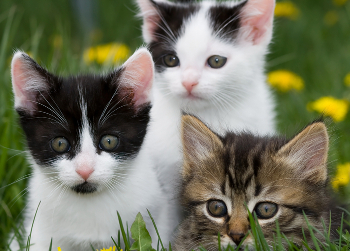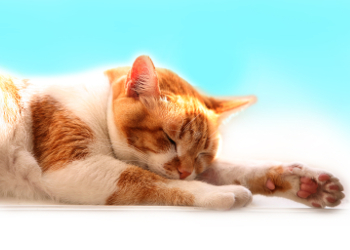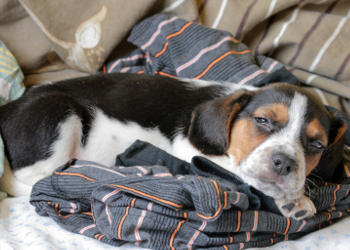Diseases #12

Ectropion is a drooping or eversion of the upper or lower eyelid most commonly seen in Mastiffs, Cocker Spaniels, English Bulldogs and others. The condition is most associated with the lower eyelid and can be caused by trauma to the eye, facial nerve paralysis (one of the 12 cranial nerves) and inflammation of surrounding ocular tissues resulting in a mechanical displacement of the eyelid.
When ectropion occurs it exposes the cornea of the eye and its conjunctiva to drying and infection. Tears are not effectively retained in the conjunctival sac and leak or drain down the side of the face on the affected eye. This "drying" effect can lead to conjunctivitis, corneal ulceration or keratoconjunctivitis (dry eye). This excessive dryness leads to the production of a greenish or yellow mucoid discharge seen in the eye.
Clinical signs revolve around the drying effect of ectropion. Dogs will scratch or paw at the effected eye. In cold, snowy weather animals will rub their faces in snow! It is very painful. The lower eyelid will actually hang down and not make contact with the eye globe. Reddening of the conjunctiva will be seen as well as a dark brown staining pattern below the eye. This staining is secondary to tear proteins running down the animals face causing a dark brown stain. This is very similar to Poodle Epiphora. seen in Toy breeds such as the Maltese or Toy Poodle.
In older animals, a CBC and Chemistry profile may be performed to check if there are any systemic causes of ectropion. Other tests performed are done to check the integrity of the eye and surrounding tissues. A fluorescein stain is performed to check for corneal ulcers. A tonometer test will check intraocular pressures. A Schirmer tear strip will be used to measure tear production levels that may be associated with keratoconjunctivitis (KCS).
Diagnosis of ectropion is made by the clinical history and findings on the physical exam.
Mild cases of ectropion may be treated with just lubricants or tear substitutes that will serve the function of tears. This will lubricate the globe and surrounding ocular tissues. If conjunctivitis is presented opthalmic antibiotics will be prescribed. If KCS is present 1% cyclosporine drops will be prescribed to stimulate tear production.
In more advanced cases, surgical repair is recommended. The eyelid is contoured to a more natural shape. This procedure is highly successful in many animals plus the eye looks more natural with a more closely adhered lower eyelid.
The prognosis for ectropion depends upon the primary cause of the disease be it neurological or trauma. If surgical repair is possible, the majority of animals sustain a very good quality of life.



Ehrlichiosis is caused by a rickettsial organism known as Ehrlichia canis. It also goes by the name of tropical canine pancytopenia.
Ehrlichiosis is seen most commonly in tropical areas of the world. In the United States it is most commonly seen in southwestern states and southeastern states, including Florida. The parasite is transmitted from one dog to another by the common dog tick, Rhipicephalus sanguineous. The disease may also be seen in combination with Babesiosis. Ehrlichia canis is able to hide from the immune system since the parasite lives and reproduces inside the red cell (intraerythrocytic).
In text books, the clinical signs of Ehrlichiosis are lumped into 3 neat little categories but in real life things are not as easily sorted out that way. There can be an acute phase (rapid and lasts several weeks), a subacute form (the animal shows no symptoms but carries the parasite) and chronic phase. This form causes the most clinical problems such as: bleeding disorders due to low platelet counts, an enlarged spleen and peripheral lymph nodes, fever and anorexia. In real life, clinical signs of each phase may be seen in a particular patient. The most dangerous stage is where the animal is an asymptomatic carrier. Ticks can feed on the animal transmitting the parasite to other dogs. It may only be detected on phlebotomy when excessive bleeding occurs. This starts one thinking about platelet disorders such as ITP, Ehrlichiosis and others.
The most important lab test is the CBC and Chemistry Profile. In the majority of cases the platelet numbers will be decreased and often a drop in the number of red cells. Once in a blue moon, the organism may be visible inside the red cell using Giemsa stain. There are PCR tests that can pick up genetic matter plus antibody tests but they are not perfect. A combination of the above are the tests usually performed.
It is actually quite difficult to trip over Ehrlichia canis organisms on routine blood smears. Even trying to find them in lymph nodes and other tissues is difficult. The diagnostic path is the finding of clinical signs, history of tick infestation and the production of antibodies to the parasite. The immune response does not happen overnight. It takes time. In an animal suspected of being infected with Ehrlichiosis, it may take 2-3 weeks for the body to mount an effective humoral response. THAN antibodies can be detected which will confirm a diagnosis of Ehrlichiosis.
Treatment of Ehrlichiosis requires long term use of doxycline to effect removal of the parasite. A minimum of 8-12 weeks is necessary for treatment. Those animals that are anemic or have developed platelet issues require whole blood transfusions.
The prognosis for Ehrlichiosis patients depends upon the severity of the infection. If diagnosed early and treated with doxycline and other supportive measures, the prognosis is good. This will not stop further infections from developing but those that do will be self limiting due to the humoral immune response developed to the first infection. Severe, debilitated animals have a much more guarded prognosis.
Prevention is the key. Without ticks, the disease can not be transmitted between dogs. Tick control is the best prevention. Topical products such as Frontline®Plus are effective as well as collars; particularly Preventic® and the new Seresto®.



Entropion is the complete reverse of Ectropion. In entropion the upper or lower eyelid is inverted towards the eye. The cause of entropion is usually genetic and it is always present by at least 10 months of age.
In bracheocephalic breeds such as the Pug their head structure makes them prone to entropion. In giant or large breeds of dogs there is plenty of loose, dangling skin that can curve inward causing entropion.
When entropion is present, the hairs on the eyelid will curve inward and start to irritate the cornea. This leads to inflammation of the conjunctiva as well as potential damage to the cornea in the form of corneal ulcers. When the animal blinks, the eyelid acts as a windshield wiper blade going up and down over the cornea. That is normal but with hairs following it, irritation will occur.
Clinical signs associated with entropion are: excessive tearing or mucous production, inflammation of the conjunctiva and hyperpigmentation of the cornea due to constant irritation. Entropion hurts and the animal will have a half closed eye and be sensitive to direct light.
A complete eye exam is in order. A common lab test is the flourescein stain. This stain will pick up any corneal ulcer or irritation caused by entropion. In normal dogs, the green flouorecent color does not "stick" to healthy tissue but does so in corneal ulcers. This delineates not only the shape but the depth of the corneal ulcer. At home, if you notice a green dye dripping out of your pets nose on the side of the problematic eye, do not be concerned. That is the way it should be and just means the dogs nasolacrimal duct is draining normally!
Diagnosis is made by the presentation of a young animal under a year of age with eye problems. The veterinarian will visibly see the entropion in the affected eye(s). He or she will also rule out corneal ulcers using the flourescein strip test. Understanding the classical breeds seen with this condition helps.
The most important thing to treat first is the corneal ulcer, if present. A mild ulcer is treated with topical antibiotics to prevent infection plus 1% Atropine drops or ointment to control the associated ocular pain. The entropion may be treated with tear supplements or by surgery. In surgery, a wedge of tissue is removed across the top or bottom eyelid and than stitched together to pull the eyelid outward. Follow up care is crucial to make sure healing is occuring as well as restaining the eye in 2 weeks to make sure the corneal ulcer is healing. When it comes to sight, follow all directions explicitly as well as all followup visits.
The prognosis for rapidly diagnosed and treated entropion cases is excellent. Untreated cases can lead to severe eye irritation and pigmentation. If there are any vascular growths on the corneal surface, an animal can lose sight in the affected eye.



The eosinophilic complex is seen clinically in cats. Eosinophils are one of the five types of white cells in mammalian blood. They are classically elevated in dogs infested or infected with parasites as well as the majority of allergies. This plays a role in the disease as well as the typical response to treatment. The cause of this complex is unknown but there may be a genetic factor not yet discovered. It can be seen in any breed of cat.
Eosinophilic complexes or granulomas are always a response to some type of allergen irritating the cats immune system. This complex is seen usually in 3 distinct forms.
1. A rodent ulcer (as it is called) or small inflamed patch of skin under the chin or on the upper or lower lips of the cats. Years ago, a huge cause of these ulcers was the irritation of red plastic food and water bowls containing a red plastic dye.
2. Small eosinophilic granulomas (scar tissue) that is usually one inch in diameter or less and are round. These may be found anywhere on the skin or inside the mouth.
3. The more severe eosinophilic plaques are almost always seen on the inner groin or abdomen of the cat causing intense misery and irritation to the animal. These plaques are about one inch in diameter and they are raised (thickened) and extend above the skin surface. The outer surface of the plaque is intensely inflamed. Many of these plaques will coalesce together and form one huge massive plaque on the cats abdomen.
The presentation in cats can vary with the individual but almost all will have inflamed reddened areas over their abdomen, face and lips or scar tissue over any part of the body. Because it has an allergic base, all cats will be in a hypergrooming mode. Constant licking which causes further hair loss is seen. Many of these cats will be vomiting or passing hairballs due to the hypergrooming. Constant licking adds moisture to the wounds and can and does lead to a intense skin pyoderma which makes the itching even worse.
The most crucial lab work procedures for eosinophilic complex are: a fecal exam for parasites, CBC, Chemistry Profile plus bacterial or fungal cultures of the skin. Skin biopsies may also be performed to get a histological diagnosis.
Diagnosis is made by noting the characteristic lesions of the eosinophilic complex on the animal. Histopathology will rule out any neoplasms such as carcinomas. The history provided by the owner is also important.
The main drug of choice for the eosinophilic complex are corticosteroids. Most veterinarians will inject an appropriate clinical dose of DepoMedrol®. One injection often works wonders, providing relief from the clinical signs. Antibiotics are used to treat any bacterial pyodermas present. If the cat will tolerate bathes, and that is a big IF, shampooing the animal in a keratolytic shampoo such as benzoyl peroxide with COOL water will provide clinical relief. Flea control should be started plus the possibility of trying a hypoallergenic diet for several months to rule out food allergy.
The prognosis for the majority of these cats is very good. They are very rewarding to treat since medical therapy usually makes the animal feel so much better. However, if the exact cause can not be eliminated in the environment, the cat may suffer a relapse at a future date. I recommend that if owners see the slightest beginning of lesions, to take the animal to a veterinarian for prompt treatment. It will resolve much quicker!



Exocrine Pancreatic Disease (Insufficiency) is seen in a lot of older dogs. Classically, it is most commonly seen in German Shepherds. The pancreas has two components: endocrine and digestive. The former produce crucial hormones for blood glucose regulation- insulin and glucagon. The latter produces numerous digestive enzymes that are secreted into the digestive tract to disgest nutrients. The main cause of this disease is chronic pancreatitis. Since it is seen often in German Shepherds, there is a probable genetic cause also.
When the pancreas decreases the amount of digestive enzymes available such as amylases and lipases, food is not broken down effectively in the small intestine. The resulting bulk present in the intestine leads to chronic diarrhea and weight loss. This weight loss is due to either maldigestion of the food or malabsorption of the food that would normally occur if enzymes were present in sufficient quantities.
The most common signs seen are: chronic diarrhea (often a red clay color) plus weight loss due to maldigestion or malabsorption of nutrients. Since food can not be broken down effectively, the animal will produce more feces than normal and at the same time continue to lose weight even though the appetite may be normal.
As with any internal medical disorder, a CBC and Chemistry Profile may show a monocytosis which is indicative of a chronic disease process going on. An important test to run is the Idexx® TLI test. A lower value will indicate a deficiency in the pancreatic function. This is probably the most reliable test.
Diagnosis is made by the history and clinical signs shown. Weight loss can occur rapidly or over a period of time. The TLI test will also aid in the diagnosis plus a history of the patient suffering from pancreatitis in the past.
Treatment of exocrine pancreatic insufficiency is based on enzyme replacement therapy. Viokase-V® is probably the best known product. It is available in pill or powder form and is administered a bit before meal time so that enzyme activity is ready to roll when the animal has its main meal. This disease is not curable but controlled. This means that the animal will have to take the drug for the remainder of its life. Avoid high fat foods. The diarrhea and weight loss should subside in a couple of weeks. Owners may want to put their pet on a highly digestible product for intestinal tract disease such as Hill's® Prescription Canine i/d.
The prognosis for patients with this disease are good as long as it is treated before there is extreme weight loss. Excess weight loss also leads to severe metabolic disorders. In those chronically ill animals, the prognosis is much more guarded.

